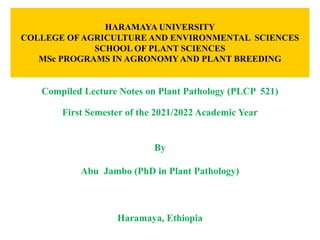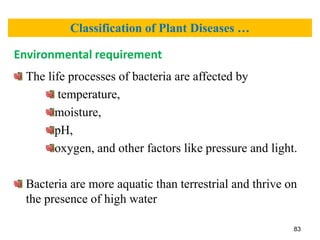This document contains lecture notes on the course "Plant Pathology" from Haramaya University in Ethiopia. It covers four major chapters: introduction to plant pathology, physiology of host-pathogen interactions, genetics of host-pathogen interactions, and plant disease epidemiology. The introduction defines plant pathology and discusses the importance of plant diseases. It also covers the classification of plant pathogens such as fungi, bacteria, viruses, nematodes and parasitic plants. The document provides details on the morphology, reproduction and nutrition of fungi as well as the identification and classification of different fungal groups.

















































































































































![146
3. Symptoms characterized by growth of the pathogen
Mildews: diseases where there is a visible mould growth over the plant
surface
Downy mildews [Peronospora spp]: where the fungal growth
consists of long condiophores growing from the diseased tissue
Powdery mildews [Podosphearia spp]: growth is characterized by
the proliferation of a surface mycelium
Rusts- powdery sporing pustuls on the leaves or stems, usually yellow, orange
or brown in color Eg.
Maize rust, Puccinia polysora
Coffee leaf rust, Hemileia vastatrix
KOCH’S POSTULATES AND PLANT DISEASE SYMPTOMS
…](https://image.slidesharecdn.com/coursepowerpointffv-221220175205-bcdffb68/85/Course-Powerpoint-FFV-pptx-146-320.jpg)


























































































































